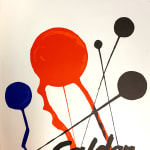Alexander Calder
Galerie Maeght, 1968
Colour lithograph
73cm x 50.5cm
Framed
Very good condition
Framed
Very good condition
Our “Modern Prints”, in the majority of cases, are posters designed by artists with the intention to advertise their exhibitions. These posters are based on an original draft by the...
Our “Modern Prints”, in the majority of cases, are posters designed by artists with the intention to advertise their exhibitions. These posters are based on an original draft by the artist. The dates printed relate to the date of the poster’s original production. In many cases the lettering was also designed by the artist.
Alexander Calder,. American 1898-1976
1968
Lithographic poster in colours on wove, for the artist's exhibition at Galerie Maeght, printed and published by Maeght Editeur — Arte, Paris, sheet
73cm x 50.5cm
American artist Alexander Calder changed the course of modern art by developing an innovative method of sculpting, bending, and twisting wire to create three-dimensional “drawings in space.” Resonating with the Futurists and Constructivists, as well as the language of early nonobjective painting, Calder’s mobiles (a term coined by Marcel Duchamp in 1931 to describe his work) consist of abstract shapes made of industrial materials––often poetic and gracefully formed and at times boldly colored––that hang in an uncanny, perfect balance. His complex assemblage Cirque Calder (1926–31), which allowed for the artist’s manipulation of its various characters presented before an audience, predated Performance Art by some 40 years. Later in his career, Calder devoted himself to making outdoor monumental sculptures in bolted sheet steel that continue to grace public plazas in cities throughout the world.
Alexander Calder,. American 1898-1976
1968
Lithographic poster in colours on wove, for the artist's exhibition at Galerie Maeght, printed and published by Maeght Editeur — Arte, Paris, sheet
73cm x 50.5cm
American artist Alexander Calder changed the course of modern art by developing an innovative method of sculpting, bending, and twisting wire to create three-dimensional “drawings in space.” Resonating with the Futurists and Constructivists, as well as the language of early nonobjective painting, Calder’s mobiles (a term coined by Marcel Duchamp in 1931 to describe his work) consist of abstract shapes made of industrial materials––often poetic and gracefully formed and at times boldly colored––that hang in an uncanny, perfect balance. His complex assemblage Cirque Calder (1926–31), which allowed for the artist’s manipulation of its various characters presented before an audience, predated Performance Art by some 40 years. Later in his career, Calder devoted himself to making outdoor monumental sculptures in bolted sheet steel that continue to grace public plazas in cities throughout the world.
2
of
2




